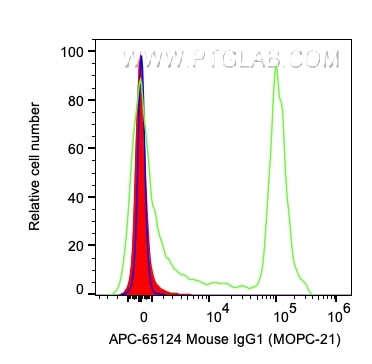Tested Applications
| Positive FC detected in |
Recommended dilution
| Application | Dilution |
|---|---|
| Flow Cytometry (FC) | FC : 0.2 ug per 10^6 cells in 100 μl suspension |
| This reagent has been tested for flow cytometric analysis. It is recommended that this reagent should be titrated in each testing system to obtain optimal results. | |
| Sample-dependent, Check data in validation data gallery. | |
Published Applications
| FC | See 2 publications below |
Product Information
APC-65124 targets IgG1 Isotype Control in FC applications and shows reactivity with n/a samples.
| Tested Reactivity | n/a |
| Host / Isotype | Mouse / IgG1, kappa |
| Class | Monoclonal |
| Type | Antibody |
| Immunogen |
N/A Predict reactive species |
| Full Name | immunoglobulin heavy constant gamma 1 (G1m marker) |
| Gene Symbol | IgG1 Isotype Control |
| Gene ID (NCBI) | 16017 |
| RRID | AB_2883010 |
| Conjugate | APC Fluorescent Dye |
| Excitation/Emission Maxima Wavelengths | 650 nm / 660 nm |
| Form | Liquid |
| Purification Method | Affinity purification |
| UNIPROT ID | P01868 |
| Storage Buffer | PBS with 0.09% sodium azide and 0.5% BSA, pH 7.3. |
| Storage Conditions | Store at 2-8°C. Avoid exposure to light. Stable for one year after shipment. |
Background Information
The MOPC-21 immunoglobulin is useful as an isotype-matched control. The MOPC-21 immunoglobulin has an unknown binding specificity and is used as an isotype control for mouse IgG1 antibodies. This antibody has been quality-tested for flow cytometry as negative control.
Protocols
| Product Specific Protocols | |
|---|---|
| FC protocol for APC IgG1 Isotype Control antibody APC-65124 | Download protocol |
| Standard Protocols | |
|---|---|
| Click here to view our Standard Protocols |
Publications
| Species | Application | Title |
|---|---|---|
Carbohydr Polym Plasmablasts induced by chitosan oligosaccharide secrete natural IgM to enhance the humoral immunity in grass carp. | ||
Cell Signal RelB promotes the migration and invasion of prostate cancer DU145 cells via exosomal ICAM1 in vitro. |




